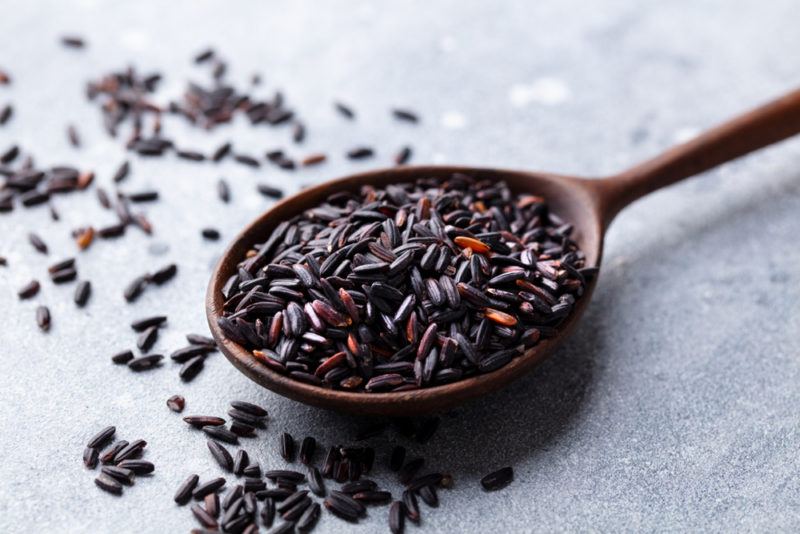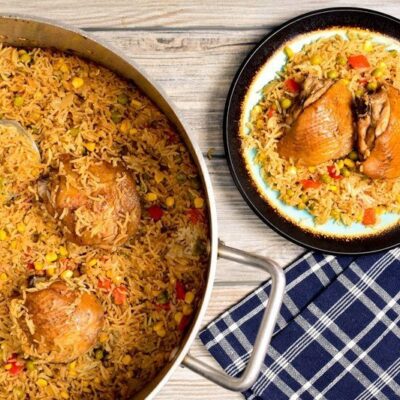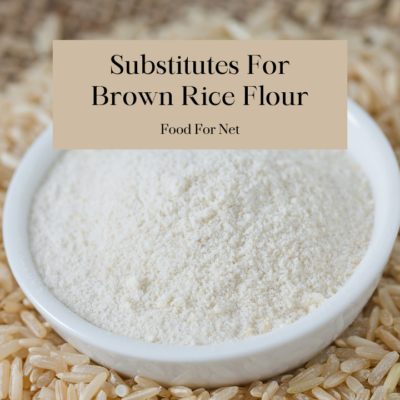
For 3.5 billion people or more, rice is a staple food. It’s one of the main parts of their diet, providing energy and nutrients, while being incorporated in countless dishes. Some estimates even suggest that rice is the single most popular food in the world. But, here’s the question, is rice good for you?
If you listen to social media trends these days, you would probably say no, rice isn’t good for you at all. Rice is high in carbs and doesn’t contain all that many nutrients, just like pasta.
Yet, rice has some surprising benefits too. Even white rice and rice noodles might be better than you expect.
Is Rice Good For You?
As you probably know, rice comes in a variety of forms. White rice and brown rice are the most well-known, but there are plenty of others too, including black rice, wild rice, and red cargo rice.
These types are different in their flavor and nutrients. This gives them different health impacts too. Even so, many of the benefits and problems of rice are true regardless of the type that you choose. So, let’s start by looking at these.
The Benefits Of Rice

It’s Extremely Practical
Rice is a staple food for one reason – it’s practical. It is easily grown in many climates, cooks quickly, and tends to be inexpensive. Rice has a long shelf life too,
In fact, if you store rice well, a packet of uncooked rice might last a year or two. This makes it a useful survival food and a fantastic backup for when you haven’t made it to the grocery store yet.
Don’t forget just how many meals rely on rice either. Sometimes rice is a main ingredient, mixed in with everything else, while other times the rice stands on its own as a side dish.
Rice Complements Other Foods
We often call rice bland – particularly white rice, which really doesn’t have much flavor to speak of. Yet, rice isn’t eaten because of what it tastes like, but because of how it works with other foods.
Did you know that rice can help to amplify other foods, making their flavors last longer on your palate? Rice is also a way of bulking out a meal, giving it more substance, without competing flavors and textures.
This is the reason that you’ll see rice in so many types of meals and as a side dish to plenty of others. Honestly, few ingredients are as versatile and easy to find as rice.
And, if plain rice seems too boring, it’s easy to make it taste better by using some spices.
White Rice Is Easy To Digest
White rice consists almost entirely of simple carbs. This is often seen as a bad thing (and it can be), but the simple carbs make white rice very easy to digest.
The effect is perfect when you need energy fast and for anyone with digestive problems. For example, many IBS suffers tolerate white rice well. White rice is also a simple choice when you’re feeling nauseous. In fact, white rice is one of the few starchy foods that don’t create gas during digestion.
Why Rice Isn’t All That Healthy

Rice holds an important place in many cultures, accompanying many meals and being integral in others. Yet, here in the United States (and plenty of other countries), we don’t think like that at all. Instead, rice is a bland ingredient, one that could be substituted for something that tastes better and has more nutrients.
Is High In Carbs
The carb content is one of the main problems with rice. White rice and brown rice both contain a little over 50 grams of carbs per cup of cooked rice. That’s a lot of carbs – and is why rice never features on low carb diets.
While the carb content is similar between brown rice and white rice, brown rice contains more fiber, while white rice is higher in simple carbs.
That distinction is important. Simple carbs are quickly brown down in our body, which leads to blood sugar spikes and could be a problem for our long-term health. Fiber, on the other hand, helps with our digestion and may provide health benefits.
But, even with the fiber, you’re getting simple carbs in brown rice too. The carb content is high enough that rice, of all types, rarely fits into a keto diet.
Wild rice and black rice are better choices for carbs, both containing a little less than 35 grams of carbs per serving. Those types can work well for decreasing your carb intake, but the carbs still aren’t low enough for keto dieters.
It Isn’t That Nutritious
Rice does contain some nutrients, particularly if you’re looking at red, brown, or black rice, or are eating enriched white rice. Even so, the amount of nutrients is relatively low compared to many other foods.
This is one reason that many people use quinoa instead of rice, as quinoa is similar in many ways, but offers more nutrients per serving.
Arsenic Levels
Arsenic isn’t good. This heavy metal is a carcinogen, one that’s been linked to a variety of health problems. And, unfortunately, rice appears to accumulate arsenic more than other grains.
The arsenic is concentrated in the bran layer, making brown rice riskier than white rice.
Arsenic levels in rice are serious enough to be concerning. Plus, much of the arsenic is inorganic, which is the type that’s likely to cause health problems. The popularity of rice combined with the arsenic levels makes rice the main source of dangerous inorganic arsenic.
Thankfully, washing and cooking your rice in low arsenic water helps to drop the levels of arsenic down (water in the United States should be completely safe to use). Swapping from brown rice to white rice can help too.
If you’re just eating rice every so often, you don’t have much to worry about. But, if you’re consuming rice or rice products most days, your arsenic levels might end up being too high.
The Types Of Rice

White Rice
White rice gets more flack than any other type. A dish of the stuff is often seen as empty calories, giving you plenty of simple carbs and hardly any nutrients. There isn’t even that much fiber, as that was lost when the husk, bran, and germ of the rice is removed.
So, is white rice healthy?
Well actually, that depends. It does still have all the benefits that we mentioned earlier, including being easy to use and storing well.
Plus, you’re rarely eating white rice on its own. You’ll often be pairing it with plenty of vegetables and some type of protein. These other ingredients help to balance out the carbs in the rice. The bland flavor of white rice is perfect in this sense, as you have no contrasting flavors to worry about.
White rice is easier to digest than other types of rice too and because the rice is carb rich, it ends up being a fast source of energy.
There’s another consideration too – the antinutrients.
Many grains have an outer layer that helps to protect them. This layer contains plenty of important nutrients, but it also has compounds that might be harmful. These compounds are there to help protect the plant from predators. They’re helpful for the plant and a potential problem for humans.
While experts argue that the benefits of grains far outweigh the problems, many people are concerned about antinutrients and avoid grains for that reason. White rice ends up being an exception to that rule, as all of the antinutrients get stripped to create white rice.
So, if antinutrients are the reason you’re concerned about eating grains, you can still enjoy white rice. This is also why white rice is considered borderline on a paleo diet, while other grains are entirely excluded.
Jasmine Rice, Basmati Rice, And Similar Options
Regular white rice has a long grain and is versatile. There are other types too, each with its own characteristics.
Jasmine rice, for example, is another type of long-grain rice. It comes from Thailand, is slightly sticky, and has a distinct jasmine flavor and aroma. The texture makes this rice excellent for cooking, as it will take on the flavors of your other ingredients.
While basmati rice is long grained too, it’s thinner than jasmine rice and seems to become even longer when it has been cooked. Basmati grains don’t stick together after cooking, which can be helpful. The floral aroma of the rice means that it works well next to curry and in pilafs.
Then there’s sushi rice. Not surprisingly, this is the rice that’s often used in sushi, largely because it’s very sticky. There are multiple varieties that all behave similarly.
Brown Rice
Brown rice is often seen as healthier than white rice. Unlike its white counterpart, brown rice is a whole grain and is less processed. Only the hull is removed when processing brown rice, leaving the bran and the germ, along with all their nutrients.
Brown rice is chewier than white rice and has a subtle nutty flavor. It’s still versatile and can be used in most dishes that rely on white rice – but opinions vary about the flavor. While some people love brown rice, others prefer the flavor and texture of white rice, and would only choose brown rice for health reasons.
While most of us would call brown rice healthier than white rice, there are some debates on this front.
Black Rice

No surprises here. Black rice is black, due to high levels of anthocyanins, which are a type of antioxidant. These anthocyanins make black rice a particularly healthy choice.
The rice has an earthy and nutty flavor. This isn’t overbearing though, so you can still use the rice in many of your favorite dishes. The flavor and texture is more similar to brown rice than to white rice, although black rice is different to both of them.
While black rice has an interesting color and plenty of benefits, it isn’t as popular as you might expect. Still, it’s worth trying out for yourself.
Wild Rice
This type of rice goes by a few names, including Indian rice and water oats. And, despite the name, wild rice might not be a type of rice at all, but instead an aquatic grass.
Wild rice is unusual in that the grains curl when they’re cooked, showing their white interior. There’s an interesting contrast here too, as the outside of the rice has a smoky flavor and is quite chewy, while the inside is mild and tender.
Red Cargo Rice
This red rice doesn’t just look fantastic. It can also be a healthy choice. Like brown rice, the outer husk of red cargo rice is removed during milling, leaving the bran and germ layers intact.
The flavor is similar to brown rice too, but red cargo rice tends to be chewier, making it an interesting ingredient to play around with.
Alternatives To Rice

A classic or not, rice is hardly your only option. Some other products can be used in much the same way as rice, but have a different balance of benefits and risks. Some might be perfect if you’re on a low carb diet, while others help you to increase your nutrient intake.
Cauliflower rice is probably the most famous rice alternative. This dish is literally just cauliflower that has been processed until it is in very small pieces. While cauliflower rice doesn’t have the same flavor and texture as regular rice, you can still use it in some of the same dishes – like cauliflower fried rice.
Some people turn to quinoa instead.
Quinoa is a pseudograin, meaning that it isn’t technically a grain, but we treat it much like one. While it’s another high carb choice, quinoa also contains more nutrients than rice, making it a powerful choice.
You could turn to other pseudograins too. There are differences in grain size, flavor, texture, and nutrients, so you’ll need to experiment to find out the best option for your meal.
There’s also shirataki rice. Like shirataki noodles, the rice is made from konjac root. It’s rich in fiber and could improve your gut health. Plus, this type of rice contains hardly any carbs or calories, making it excellent for many situations.
Opinions about shirataki rice vary, so you’ll need to try the rice for yourself to see what you think. Some people are put off by the strong smell when the packet is first opened. While rinsing the rice helps a lot, some of that smell still remains.
Should You Eat Rice?
Rice doesn’t sound like the greatest addition to your diet. White rice contains few nutrients and other types of rice, while they’re more nutritious, often contain antinutrients as well. Plus, rice is considered a grain and is high in carbs.
If you’re following a low carb diet, then rice simply isn’t going to work.
In other cases, rice can still be useful. After all, your nutrients come from your diet as a whole. You don’t need to optimize every single ingredient to eat well. Rice, even white rice, can still be part of a healthy diet if you’re combining it with nutritious ingredients.
Need proof? Just look at Japanese food. Many of their dishes rely on rice, yet Japanese people are often much healthier than westerners. Clearly rice can be good, if the rest of our diet is well balanced.
Frequently Asked Questions
Is Rice Bad For Diabetics?
White rice isn’t ideal for diabetes, as it has a high glycemic index (GI) and can quickly cause a blood sugar spike. Eating large amounts of white rice regularly could also increase the risk of diabetes and of diabetes complications.
The fiber content of brown rice makes it a much healthier choice, one that doesn’t have such a strong blood sugar effect.
That said, diabetics can still consume white rice, as long as they keep the portion size small and pair the rice with plenty of fiber- and protein-rich foods. Doing so decreases the blood sugar effect, creating a healthier meal.
Is Rice A Complex Carb?
Complex carbs get their name from their structure, as they have complex chains of sugar that take time to break down. The increased digestion time is good for our body, as it reduces the effect on your blood sugar levels.
Rice is sometimes called a complex carb food, as most of the carbs are starch. However, white rice is still processed and misses many of the nutrients and much of the fiber present in brown rice. Because of this, brown rice is a much better source of complex carbs than white rice.
Is Rice Acidic?
Rice is slightly acidic. The pH generally ranges from 6 to 7, with differences from one type of rice to the next. This isn’t surprising, as most foods made from grains are somewhat acidic.
However, the acidity isn’t dramatic and shouldn’t be a problem for most people. Some alkaline dieters even still eat rice regularly.
Is Rice A Processed Food?
Processing levels vary depending on the type of rice you choose. Brown rice tends to be minimally processed and mightn’t even be processed at all.
In contrast, white rice goes through considerable processing. This includes polishing the rice kernels to leave just the white endosperm.
Is Rice Bad For Gout?
Many grain products are fine for people with gout, including rice, bread, and pasta. These foods all have very low levels of purines (the main exception is oatmeal, which has a moderate purine content).
Brown rice is the best choice, as this has a lower GI than white rice. The lower GI is important, as the blood sugar effect from high GI foods can increase the risk of gout flareups.









 Best Foods to Eat for Lunch
Best Foods to Eat for Lunch
Leave a Reply